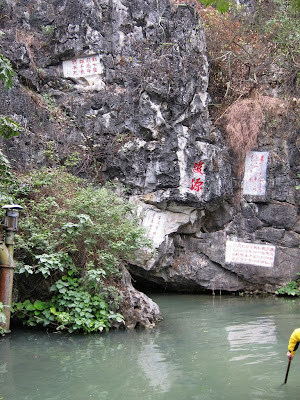























































Firstly, I introduced the HKSTP through the corporate video and then presented the quality management system in Technology Support Centre (TSC), including ISO 9001, OHSAS 18001 and ISO 27001 certification, as well as, ISO 17025 (HOKLAS / CNAS) accreditation. After that, we visited our different laboratories such as Probe and Test Development Centre (PTDC), Reliability Laboratory (RL), Wireless Communications Test Laboratory (WCTL), IC Failure Analysis Laboratory (ICFAL), Material Analysis Laboratory (MAL) and Biotechnology Support Laboratory (BSL)

Some photos were taken for memory below:
I explained the IC tester working in cleanroom.

Group photo in PTDC (Rigth first: Dr. Calvin Chui)
I introduced the X-ray Inspection technique in ICFAL.
Then Scanning Electron Microscope was briefed.
I explained the Auger Electron Microscope to visitors.
After that they visit the Charles K. Kao Auditorium (Golden Egg) of HKSTP and take photo for memory.
Then we visit "Professor Charles K. Kao: Father of Fibre Optics" Showcase.
We took photo inside Golden Egg (It has around 280 seat.).
Finally, we visited BSL. I briefed the culture room facilities to visitors.
At the end, we took a group photo in front of Biotech SME Centre.
Reference:
Master of Engineering in Engineering Management of OUHK -
http://sct.ouhk.edu.hk/engsc/meng/
今天, 新力量網絡及香港教育學院文理學院合辦「全球公民:全球化時代的通識教育」公眾研討會. 目的是探討通識教育如何定位, 中學及大學的通識課程應如何改革.

首先由方志恆先生(新力量網絡副主席)主持這場研討會. 研討會是讓在座兩位講者用十五分鐘說出對題目的看法. 之後由聽眾發問.
第一位講者是呂大樂教授. 他說全球化不只是國家內部作界線. 如環保問題. 而是說怎樣成為負責任的地球人? 而通識教育的出現是多元化及重思考.
呂教授說從前大學教育是專門化, 又因在60/70年代的香港本土化, 當年人生的發展和現在很不一樣. 所以畢業的同學不一定要留在香港. 而大學是幫助培育全球公民.
第二位講者是莫家豪教授. 他談到香港要是亞洲國際都會, 首先要強化對亞洲 (及中國) 的了解. 課程要把亞洲內容豐富化. 在2008年前, 全球化等同美國化. 但現在全球化不等同西化.
莫教授說現在的顧主心目中理想大學畢業生要有以下的才能:
l Problem Solving
l Criticization
l Creative and Innovative Thinking
l Ethic Understanding and Decision Making
l Effective Communication
l Global View and Asia Understanding
在答問環節中, 我們討論到成人教育, 專業, 本土化等等.
呂教授說不應把地區化, 本土化, 全球化分隔. 他說通識課的最大功效是在於思考方法及寫作方法. 而大學和中學的通識課是兩回事.
莫教授說增加通識的深度及量度如提升思考及分析能力. 從前是篩選學生上大學, 應試為目標. 現在教育要改革, 避免高分低能, 要培訓對全球有競爭性的人才. 尤其是文化人才.
我個人認為在大學課程中, 應先專後廣 (即先本科後通識). 我在這裡和呂教授有些出入.
Reference:
http://www.synergynet.org.hk/b5_m9_detail.php?id=1219
Hong Kong Society for Quality (HKSQ) organized a study mission to visit ZhaoQing Asia Aluminium Factory Co., Ltd. (肇慶亞洲鋁廠有限公司) and Leading Edge Construction Materials Testing Co., Ltd (領鋒建材檢測有限公司) on 21 & 22 Jan 2011. America Society for Quality (ASQ) was supporting organization.
In the second day, we visited Leading Edge Construction Materials Testing Co., Ltd. It was only 3 degree Celsius (°C) in the morning!

Mr. Gavin Yi (Laboratory Manager) introduced different testing to us included:
l Performance test for building facade
l Fire resistance test for building materials
l Performance test for fixed fire fighting systems
l Performance test for building materials

After that we went outside to a large testing chamber for demonstration. Mr. Thomas Tsang (General Manager) explained the testing background to us.

Inside the testing chamber, we observed some gauges to measure deflections of the structural members under load during the test.

It demonstrated the water penetration test on site.

The aircraft propeller was used for dynamic water penetration test. It was able to produce 56.8m/s wind speed (about 2kPa wind pressure).

We took a group photo in front of the Mock-up Testing Chamber which is made of reinforced concrete with 130.6m Long times 30m High dimension.

Inside the test centre, many different fire resistance tests were performed in here.

It demonstrated the flat vertical furnace which was used for testing fire resistance properties of glazed door set or timber door set.


It tested the load bearing column assembly.

It demonstrated the fire resistance test of the flat-plate photovoltaic modules and panels.

I represented HKSQ to present souvenirs to Mr. Thomas Tsang (General Manager).


And presented to Mr. Michael Fan (QA Manager).

Also presented to Mr. Gavin Yi (Laboratory Manager).

We had taken a group photo in Leading Edge Construction Materials Testing Co., Ltd.

We left at noon and saw some goats in truck.

It had some time that we decided to visit the Seven-Star Crags for 1 hour.

It was wonder that the Star Lake National Park had achieved ISO 14001 certification.

The ISO 14001 certification was shown.

We hired a golf car to visit Seven-Star Crags.

Some photos were taken for sharing.

Seven-Star Bridge



It was a nice trip and we all had more understanding on Aluminium industry and construction testings.
Reference:
Leading Edge Construction Materials Testing Co., Ltd. (領鋒建材檢測有限公司) : http://www.le-testlab.com/